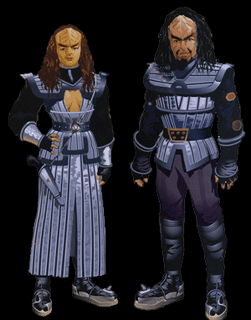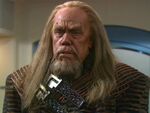 Klingon Female and Male | |
| Klingon | |
|---|---|
| Universe | Star Trek Universe |
| Homeworld | Qo'noS (Pronounced Kronos) |
| Average Height | Average to a Human |
| Diet | Omnivorous (Mainly eats meat) |
| Sapience Level | Average to a Human |
"A Klingon's honor means more to him than his life!" – Kurn
The Klingons (Klingonese: tlhIngan) were a humanoid warrior species that originated from the planet Qo'noS (pronounced Kronos), an M-class planet. One of the major powers of the galaxy, the Klingons were a proud, tradition-bound people who valued honor and combat. The aggressive Klingon culture had made them an interstellar military power to be respected and feared. Klingons believed that they had the instinctive ability to look an opponent in the eye and see any intent to kill.
History and Politics
The Klingon Empire was founded some time in the 9th century by Kahless the Unforgettable[[1]], who performed many heroic feats including the unification of the Klingon people when he killed the tyrant Molor[[2]]. Kahless came to be revered in Klingon society to the point of near-deification, and many aspects of Klingon culture came to revolve around emulation of Kahless's life. (TNG: "Rightful Heir")
The warrior ethos had been an important aspect of Klingon society since the time of Kahless, but the warrior aspects became much more dominant beginning in the early 22nd century. Previously, Klingon society was regarded as socially balanced, but over time the warrior caste gained greater prominence, to the point where the Klingons widely came to be regarded as a "warrior race." (ENT: "Broken Bow", "Judgment")
Because of their aggressive outlook, the Klingons generally had poor relations with other races after they began to move out into space. Because the worlds of the Klingon Empire were resource-poor, the Klingons developed an intense belief in the need for expansion and conquest in order to survive. The Klingons' relationship with Humans and the Federation was rocky at best. Following the disastrous First Contact between Klingons and Humans, tense rivalries and unavoidable conflicts often developed between the two races. (TNG: "First Contact"),
In the year 2154, the Klingons gained access to the genetic material of Human Augments and tried to adapt this genetic engineering to improve themselves. An unanticipated side effect was that the Augment DNA caused the characteristic Klingon cranial ridges to dissolve.
The test subjects did gain increased strength and intelligence, but then their neural pathways started to degrade and they died in agony. One of the subjects suffered from the Levodian flu[[3]], which was modified by the Augment DNA to become a fatal, airborne, mutagenic plague that spread rampantly among the Empire, from world to world. In the first stage of this plague, Klingons lost the ridges on their foreheads and began to look more Human.

Dr Antaak after loosing his ridges from the Levodian flu
With the help of a Klingon scientist named Antaak[[4]], Dr. Phlox[[5]] of the Earth starship Enterprise was able to formulate a cure that halted the genetic effects of the virus in the first stage. This retained the changes in appearance along with some minor neural re-ordering. The neural ordering caused changes in the emotional make up of the Klingons. For example, the infected started to feel fear. Even though the infected did not develop any stage-two characteristics, such as enhanced strength, speed, or endurance they did not die from it. This left millions of Klingons changed. These alterations were even passed on to their children. (ENT: "Affliction", "Divergence")
- The virus must have been cured before 2273 since we see Klingons with ridges in Star Trek: The Motion Picture. We also see other Klingons like Kang (lacking ridges in TOS: "Day of the Dove" thus having the virus. We then see him with forehead ridges in VOY: "Flashback[[6]]" after he was cured. It should be noted, however, that Kang's and other like Klingon's ridges may be a result of surgical cranial reconstruction.
- It is possible that at first the treatment only gave many Klingons a single ridge from the bridge of the nose across the forehead, and then was eventually perfected and allowed a complete return to the original form. This speculation comes from the fact that many Klingons seen during the 23rd century possessed rather minor ridges (such as Chang[[7]], Korrd[[8]], and Azetbur[[9]]). Of course this could be simply the differences in appearance between Klingon sub-races.
- It has been suggested that the disease afflicting the Klingons seen in VOY: "Prophecy", Nehret[[10]], is the modified Levodian flu. The Doctor[[11]] manages to cure the Nehret using stem cells from B'Elanna Torres'[[12]] daughter, who was ¾ Human and ¼ Klingon, suggesting a similar method was used to cure the Humaniform Klingons.
Klingons were apparently so embarrassed by the fallout from their failed attempt at genetic enhancement that they refused to discuss the incident with outsiders. Due to the secrecy of the Klingon Empire, knowledge of the change became lost over time to the general population of the Federation. By the 24th century, the reason for smooth forehead Klingons was not widely known outside the Empire, and questions were generally met with a brusque answer along the lines of "we don't discuss it with outsiders." (ENT: "Affliction", "Divergence"; DS9: "Trials and Tribble-ations")
- It has been speculated that the events of the Temporal Cold War[[13]] have complicated the "original" timeline of interstellar history. According to this theory, first contact between Earth and the Klingons was supposed to have occurred during the Augment Crisis[[14]] of 2154, but the Temporal Cold War altered historical events, causing the contact to take place prematurely in 2151.
By 2223, relations between the Federation and the Klingon Empire degenerated to a point of unremitting hostility, which lasted for several decades. (Star Trek VI: "The Undiscovered Country"; TNG: "First Contact")
The lingering tensions between Klingons and humans continued to rise, eventually leading to the Battle of Donatu V near Sherman's Planet in 2245, and later erupted into what was considered the first Federation-Klingon War in 2267. This war was quickly ended by intervention by the Organians after only four days of fighting. (TOS: "The Trouble with Tribbles", "Errand of Mercy") Over the next several decades, an uneasy peace developed that was broken by brief but fierce skirmishes and conflicts (Star Trek III: "The Search for Spock"; "Star Trek V: The Final Frontier"). A true and lasting peace finally came in 2293 with the signing of the Khitomer Accords[[15]], thanks to the efforts of Chancellor Gorkon[[16]] and the Human Starfleet officer James T. Kirk[[17]]. (Star Trek VI: "The Undiscovered Country") Since then, despite several periods of rocky relations (see Federation-Klingon War (2372-73)), the Federation and the Klingon Empire have been steadfast allies, especially in the face of Dominion aggression in the 2370s. (DS9: "By Inferno's Light")
- Apocryphally, the game Starfleet Academy further explores the conflict between the Federation and Klingons in the years leading up to the Khitomer Accords. In the game, a series of border skirmishes are resolved when it is discovered that an unknown alien has been behind attacks on both Federation and Klingon border planets. This then helps to establish the foundation of the Khitomer talks.
The Klingon relationship with the Romulan people was also extremely unstable. A short-lived alliance and technology exchange notwithstanding, the Romulan Star Empire were typically regarded by the Klingons as a "blood enemy" since at least the 23rd century. Sporadic Romulan attacks against Klingon colonies (see Khitomer Massacre[[18]]) and interference in Klingon affairs (see Klingon Civil War[[19]]) continued to sour relationships between the two peoples. (TNG: "Sins of the Father", "Redemption II")
In the mirror universe, the Klingons were a founding race of the Klingon-Cardassian Alliance, where they formed an alliance with that universe's Cardassian counterparts. (DS9: "Crossover")
According to Daniels[[20]], the Klingons joined the Federation by the 26th century. (ENT: "Azati Prime")